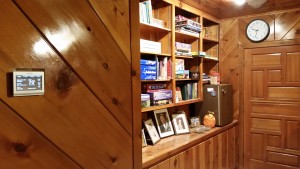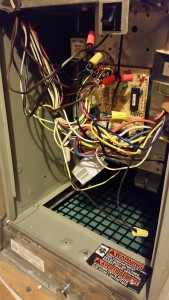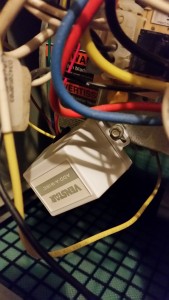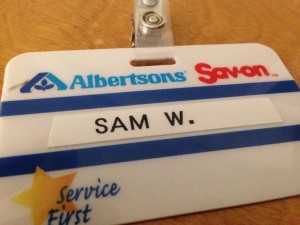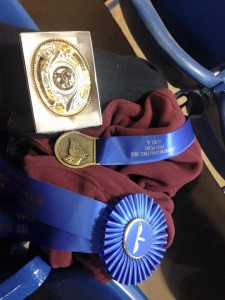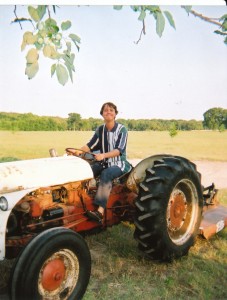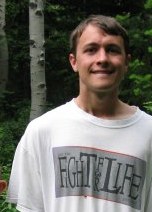adults with autism
Smart thermostats anywhere
By Sam Wolfe, Guest Blogger
According to the recently published news story, “Smart thermostats remember for you,” a thermostat that is “just about as smart but doesn’t connect to the Internet” was installed in the back side of this home. (We live in northwestern Denton.)
Only one wire was available to power the thermostat. According to HVAC technician Bill Clark, the thermostat pictured in this story needs two wires to operate, a hot wire and a common wire, as do all other smart thermostats you can buy.
Research shows that the common wire is not available in some applications with a non-heat pump system. This requires battery power to a digital thermostat. Only a conventional thermostat or a programmable thermostat (one that is “just about as smart but doesn’t connect to the Internet”) could be used in these applications … until now.
With a Venstar Add-a-Wire accessory box and diode, you can simply “turn one wire into two.” For more information about this accessory, follow this link:
Note from Peggy: Sam was terribly disappointed after we were able to install an internet-ready thermostat in my house, but not his apartment. (For want of that wire. I wasn’t going to pay to lay more wire in the attic.) He went in search of a solution to that problem and found the add-a-wire device. After I asked him to make sure it was UL-listed, he ordered it, and then installed both the add-a-wire and the internet-ready thermostat in his apartment (which is in the back of the house) himself. He took the photos of his handiwork so you can see what he did.
More fun with Arduino
I asked Sam if these little Arduino computer-building projects he does once a month at North Branch Library was just building, or coding, too.
He says he has to edit code to get the devices to do what he wants them to do.
Here are two more short videos of the results of the build. A timepiece and a pinwheel (but you tell me if it doesn’t make you think of a jumping bean.)
Reflections on nine years and three days
Saturday we took care of errands ending up at the grocery store just before lunchtime. About halfway through our trip, we saw an assistant manager leading three new trainees around the store, pointing out the location of various items.
Sam stopped and watched for a second. Then he announced that three days before was the ninth anniversary of his date of hire.
Wow. Time flies.
The good people at Albertsons hired him as a courtesy clerk the summer after he graduated high school. He had help from a job coach, hired by the state, to make sure he got off to a good start.
Sam has received lots of raises through the years but he hasn’t sought promotions to jobs like checker or stocker because he doesn’t feel the kinds of problems they manage are the kinds of problems he could solve quickly.
His favorite part of the job is retrieving carts. If you catch him heading out the door to fetch carts, you will see him ride a cart like a skateboard to the far side of the parking lot. He tells me it’s a move he invented.
Sometimes, he says, the managers tell him there’s enough carts for now, and he needs to come back inside to help sack groceries.
He’s a good sacker, but he he thinks that the speedy sacking champions who used to make an appearance on The Late Show with David Letterman are just crazy.
Although I don’t have it on any authority at all, the store seemed too quiet after Wal-Mart opened at Rayzor Ranch. But recently, it’s been busy no matter what day or time I visit the store. I don’t know the reason, although I have my theories. People are struggling with the construction on University Drive. And more than once I’ve heard someone say they are tired of the crazy parking in the lot outside Kroger.
Who knows how much longer he’ll be there. He just headed out the door right now to walk to work. He’s a cheerful, reliable employee. When we were shopping yesterday, everyone, including the store manager, stopped to say hello.
As wonderful as working at Albertsons has been, and will likely continue to be, Sam should be celebrating his second or third anniversary in the tech sector. That’s what his degree is in. That’s where his talents are. That’s what the contract says with his new job coach.
The IT sector is desperate for employees. Sam’s brother, Michael, didn’t major in IT, and yet that is where he landed. It’s hard not to feel irony’s burn. We worked so hard to get to this point. Sam’s ready for the world. But the world isn’t ready for him at all.
Building Arduinos
Tonight was Sam’s second time to go to North Branch Library and their meet-up group for Arduino. Sam says there’s a lot to explain about Arduino. “The possibilities are endless,” he says. “You can build drones. But today, it was mostly about building electronic musical instruments.”
For example, he built this little theremin today.
He calls it a light theremin because it changes its sound frequency based on different levels of light.
He also built this little keyboard. “It’s not exactly a keyboard,” Sam says. “It’s just buttons.”
Tale of two clocks
It’s been long enough in the new house that the second bill for internet service arrived in the mail this week. I count it a personal achievement that I have left work brain-drained and exhausted more than once these past four weeks and never pointed the truck the wrong way home.
That’s 20 years of driving habits undone, just like that.
Sam felt comfortable enough with the set-up of his apartment, completely separate yet conveniently located behind the house, to post a triumphant photo on Facebook this week. He had all his boxes and bags unpacked within a week. That included filling a wall of shelves with books and games. But, in true-t0-Sam fashion, he didn’t consider it all done until the wifi, Chromecast and a new clock got installed.
This Monday was the first time he was able to watch one of his favorite shows, Dancing with the Stars, in a long time.
Sunday his clock arrived. He had ordered it a few days before on Amazon. All his mobile devices display the current time, but he still wanted a big, traditional clock on the wall.
Well, almost traditional.
I bought a clock on Sunday, too. We were at the Denton Arts and Jazz Fest. An artist there built clocks in sturdy oak frames and printed out clock faces filled with inside jokes. Sam was still reading clock faces by the time I finished my purchase of a “writer’s clock,” with hours and hours of “write” or “revise” and the end of the “writer’s block” hour coming with the “adult beverage” hour.
I chuckled when I got it home and read the insert on how to power up and set the time on the clock. The artist may have set up shop for the weekend in Denton, but he lives just down the road from my family in Colorado.
Sam’s clock required no effort on his part to set. That was all taken care of by the satellite it signaled.
Of course.
Overheard in the Wolfe House #286
See Sam Drive: Tractor Edition
Sam and I re-homed the tractor today, one of many steps away from the farm and toward life in town.
He drove the tractor as I followed him in the pickup, loaded up with nearly all the tractor accoutrements Mark had acquired over the years, down Frenchtown Road for the last time.
Mark taught Sam to drive the tractor when he was a teen. He wanted Sam to learn to drive a car and figured this was a good way to see how he’d manage. Better to mow down a few trees or knick a fence or two in the relative safety of your Texas-sized front yard in that journey of self-discovery.
Mark was right. Sam could do it. When he pulled the tractor up under the carport this afternoon and parked it perfectly, Susan exclaimed, “Wow, Sam, you’re a professional!”
Sam wasn’t going to tolerate any tears from me, so I blinked them back behind my sunglasses.
“I made it!” he beamed.
Other deadly encounters: police and people with autism
When Sam was 14, he enjoyed hopping on his bike and pedaling around the neighborhood. We knew he didn’t go far, maybe a mile or so, and back then our country road was quiet. We appreciated that he had found his way to explore the world. We thought that was important for his growth and development, so we tried to keep our worries in check.
He went out on his own one day when Mark and I had gone somewhere on an errand. When we returned, we were surprised to see a police car parked in front of our garage. In no time, Mark was in between the officer and Sam, who was pacing in the back of the garage, talking to himself, as the officer stood in the doorway trying to question him.
My heart was pounding. I could only stand there and watch. The officer left shortly after we arrived, but I knew Sam was in trouble.
It took some time to piece the story together.
Sam had pedaled down a new street, where a handful of large new houses were being built. He saw that many of the windows had been broken in one of the houses under construction at the end of the cul-de-sac. He got off his bike and walked up to take a closer look just as the officer was making his rounds. Sam scrambled back on his bike and rode home as fast as he could, with the officer chasing him in his car.
According to the officer, Sam was repeating the phrase, “Yep, it looks like I did it,” as he was pacing in the garage.
The officer wanted Sam to submit to a footprint, but we refused. The officer already had him at the scene. Our further cooperation wasn’t going to help Sam. We knew it was out of character for Sam to throw rocks at windows, but we couldn’t be completely sure. And we knew, too, that most every parent has probably insisted to police that their child “would never do that,” when, in fact, they had done whatever it was they were in trouble for.
As communities all around the nation, from New York City to Ferguson to Los Angeles, demand more from their relationships with their local police, I can’t help but think that in another city or another time, the outcome of that chase would have been totally different for Sam.
I was grateful that our local police didn’t overreact, but I couldn’t leave the situation as it was.
About five years before that drama in the driveway, just after we moved to Texas, I was horrified to read about Michael Clement, a teen with autism who had been killed by Plano police. His parents traveled to Michigan for their older daughter’s college graduation and hired a caregiver to take him from school to home. When the caregiver took him to a group home where she worked instead, Michael got upset. The staff at the home lost control of the situation and called police, who were even less prepared to deal with an upset young man with autism. According to court records, the officers were in the house just 19 seconds before killing Michael, who was suspected to have been holding a knife when he came out of the kitchen.
After I read the story, I shared it with a good friend, the late Don Louis, who worked as a grant writer and project developer at the University of North Texas in what was then the School of Community Service. Don convened a group of experts, and facilitated several fact-gathering conversations that included Michael’s parents, Pauline and Warren Clement, eventually developing a training module for police.
It was well received, including being approved by the state for the official police training curriculum, although for their continuing education.
I asked Don to get me a copy of the training manual to take to the police chief. I called my good friend, Judy Martin, who had a son with autism, too, and we asked for a meeting with him. Judy and I reminded the chief that our boys were just the first of a wave of youngsters with autism that would soon be teenagers and likely to have encounters with police as they aged. I was happy that the chief came prepared for our meeting and was receptive to the materials.
I knew that wasn’t necessarily the end of Sam’s trouble, with an open investigation into that vandalism and him at the scene, but I was glad we made the overture.
About a month later, I happened to be sitting in a town council meeting when the chief updated the council on the department’s activities. It turned out a group of boys from another nearby neighborhood had been caught vandalizing and they confessed to breaking the windows of the home where Sam had been.
As he made the announcement, he looked over his shoulder and gave me a knowing glance. That night, I told Mark and Sam that he was finally in the clear.
The situation traumatized him, though. We made a concerted effort for him to trust police again. It helped that the officer who had chased him down the driveway was often on school grounds and he reached out and talked to Sam.
But he still gets nervous when he sees an officer. And he never rode bike again.
Overheard in the Wolfe House #283
Peggy: You work today, right?
Sam: Yes, 4 p.m. to 10 p.m. Back on schedule again.
Peggy (noting the long string of days off): It was almost as if they forgot you.
Sam: Yes. But you can’t forget them.
Overheard in the Wolfe House #279
Peggy: How was your day today?
Sam: Eye appointment was good.
Peggy: Wonderful. So how was horseback riding today?
Sam (pauses): The eye appointment was better.
